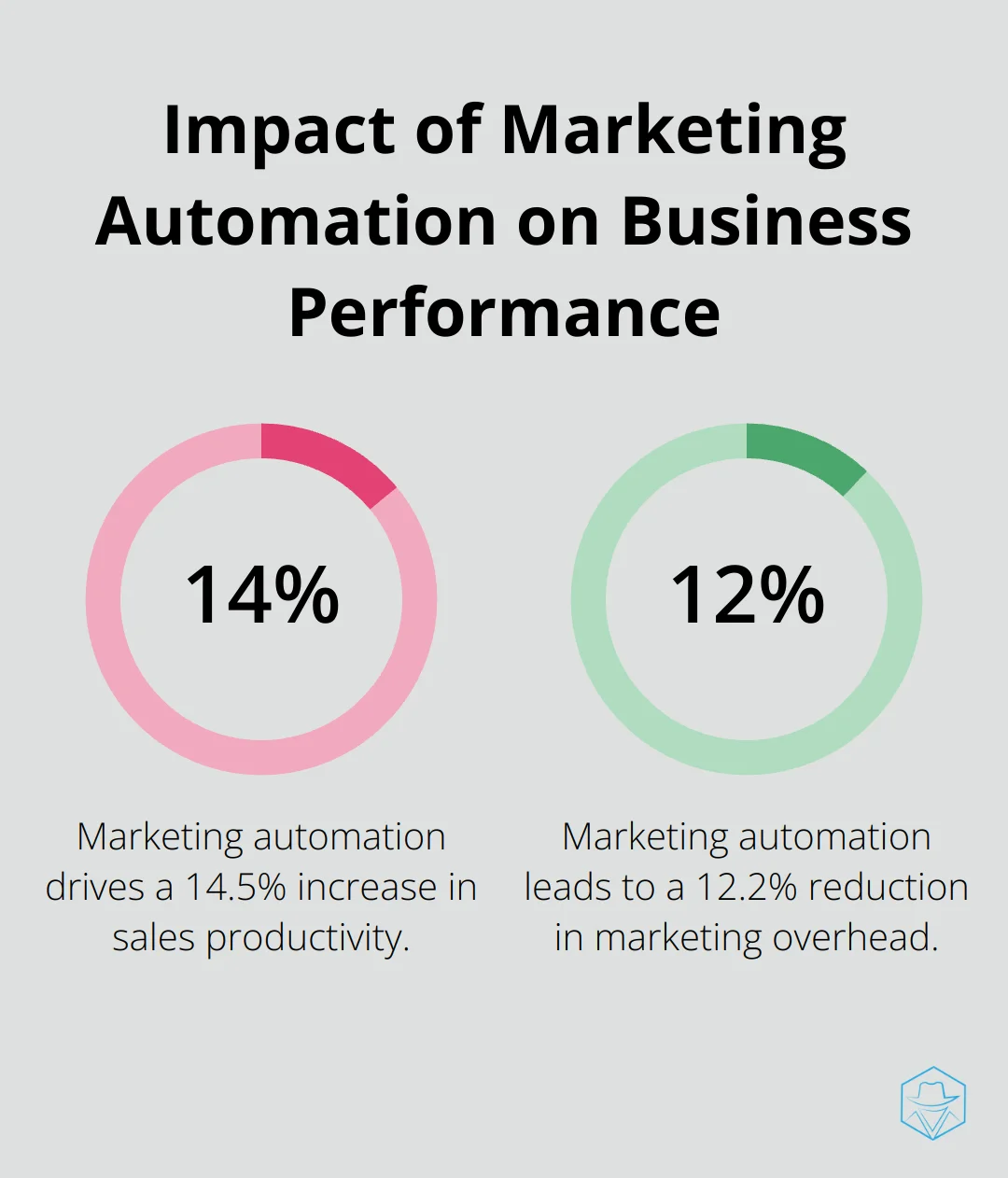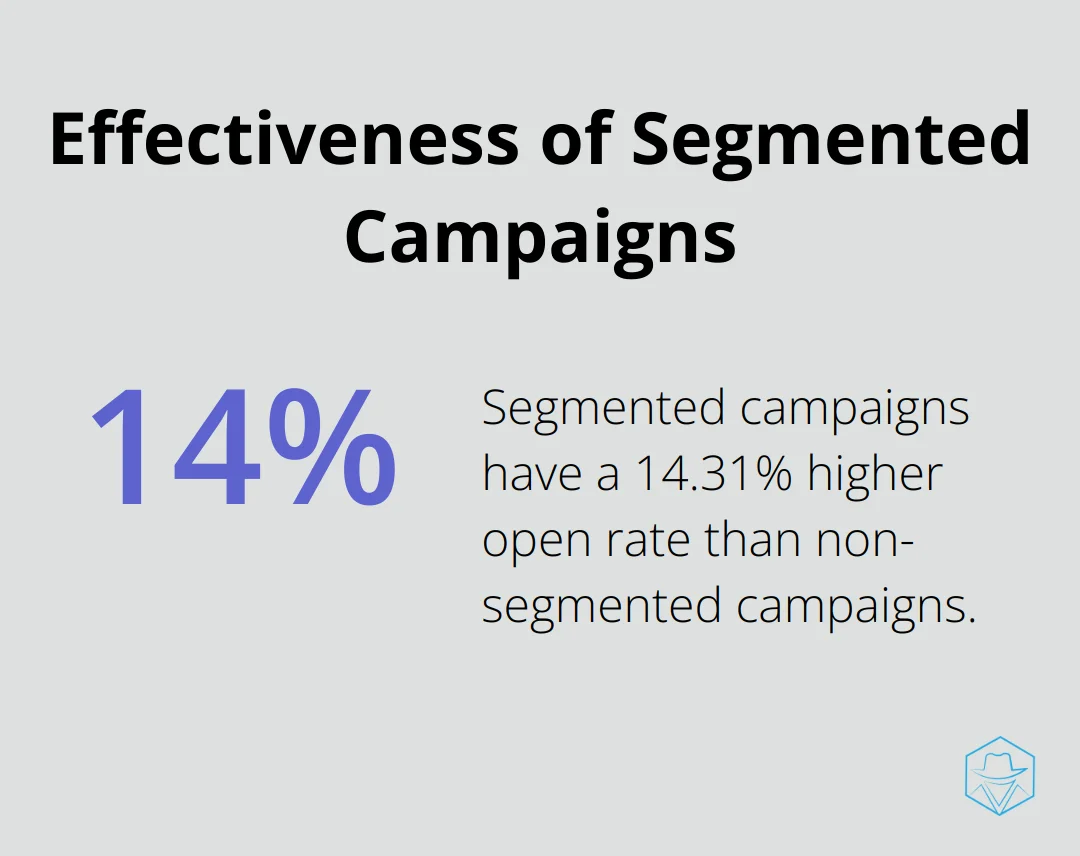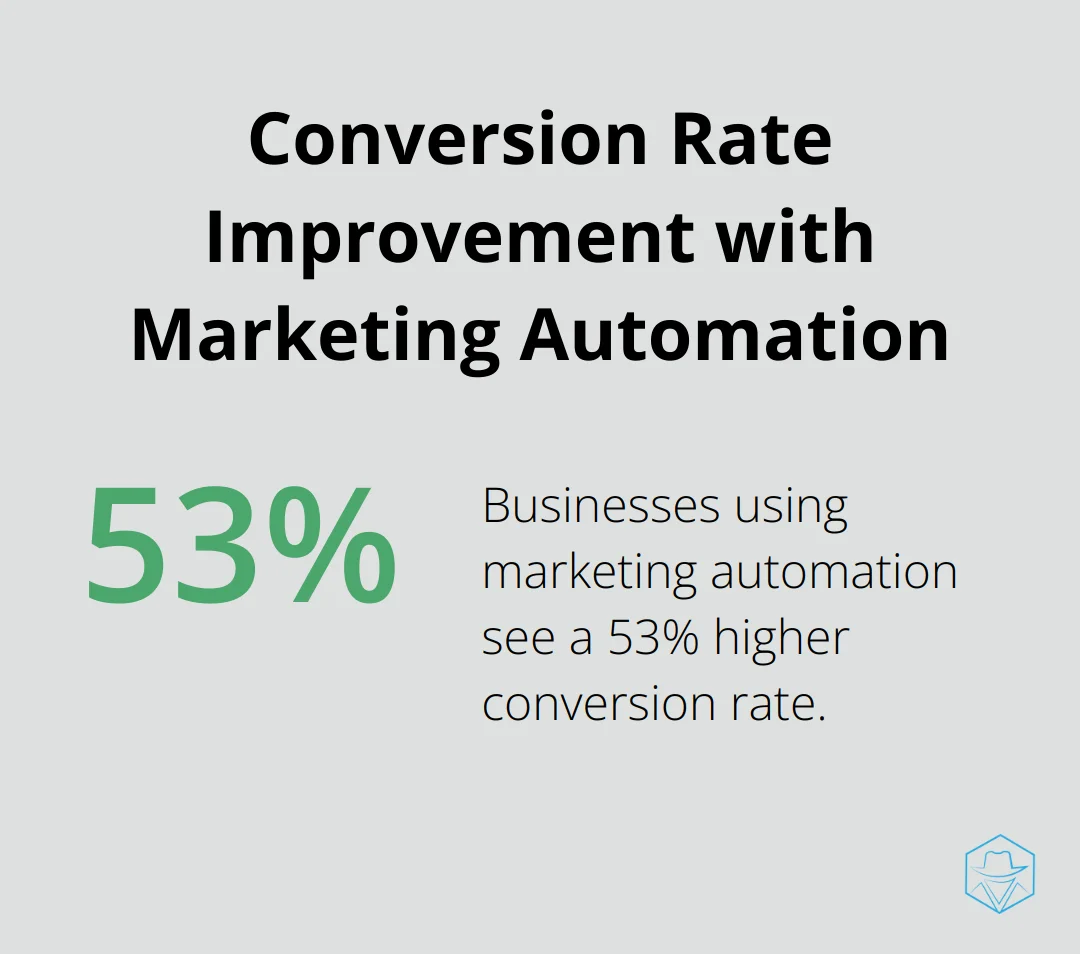Marketing Automation in Customer Relationship Management

At Drop Cowboy, we’ve seen firsthand how marketing automation in customer relationship management transforms businesses. This powerful combination streamlines processes, enhances customer experiences, and drives growth.
Marketing automation and CRM integration offer a wealth of benefits, from improved lead nurturing to personalized communication at scale. In this post, we’ll explore strategies for effective implementation and how to measure success in your automation efforts.
What Is Marketing Automation in CRM?
Marketing automation in CRM revolutionizes how businesses manage customer interactions and boost sales. This powerful combination uses software to automate repetitive marketing tasks and processes, allowing companies to nurture leads, personalize customer experiences, and measure campaign effectiveness with unparalleled efficiency.
Key Components of Marketing Automation
The foundation of marketing automation in CRM consists of several essential elements:
- Lead capture forms
- Email marketing tools
- Customer segmentation capabilities
- Analytics dashboards
These components create a seamless marketing ecosystem. For example, when a potential customer completes a form on your website, the system automatically adds them to your CRM and segments them based on their interests. This action triggers personalized email sequences, ensuring each lead receives relevant content at the optimal time.
Measurable Benefits for Your Business
The integration of marketing automation with CRM yields substantial benefits. A study by Nucleus Research reveals that marketing automation drives a 14.5% increase in sales productivity and a 12.2% reduction in marketing overhead. These impressive figures translate to tangible improvements in business performance.

Marketing automation empowers sales teams to focus on high-value activities (such as closing deals and building relationships) by automating routine tasks. Simultaneously, marketing teams can create more targeted campaigns, resulting in higher conversion rates and improved ROI.
Smooth Integration with Existing Systems
Integrating marketing automation with your current CRM doesn’t require a complex overhaul. Most modern CRM platforms offer built-in marketing automation features or straightforward integration with third-party tools. Salesforce’s Marketing Cloud, for instance, integrates seamlessly with its CRM, providing a unified view of customer data across sales and marketing departments. Similarly, HubSpot’s all-in-one platform combines CRM and marketing automation functionalities out of the box.
When selecting a solution, consider your specific needs and existing tech stack. Look for platforms that offer robust APIs and pre-built integrations to ensure smooth data flow between systems. The ultimate goal is to create a unified ecosystem where customer data informs marketing strategies, and marketing activities feed back into the CRM to provide a comprehensive view of each customer.
As we explore the strategies for effective marketing automation in the next section, you’ll discover how to leverage these powerful tools to maximize your business’s potential and drive sustainable growth.
How to Supercharge Your Marketing Automation
Master Customer Segmentation
Effective marketing automation starts with understanding your audience. Divide your customer base into distinct groups based on shared characteristics (demographics, purchase history, or engagement levels). For example, a B2B company might segment its audience by industry, company size, and decision-maker role.
Tailor your messaging to each group. A Mailchimp study found that segmented campaigns had a 14.31% higher open rate compared to non-segmented campaigns. This personalized approach ensures that your communications resonate with each recipient, increasing the likelihood of engagement and conversion.

Implement Dynamic Lead Scoring
Lead scoring prioritizes your sales efforts. Assign point values to various actions and attributes of your leads. For example, downloading a whitepaper might be worth 10 points, while visiting your pricing page could be 20 points.
Create a system where leads automatically move through your sales funnel based on their score. When a lead reaches a certain threshold, trigger an alert for your sales team to make contact. This ensures that your team focuses on the most promising prospects, increasing efficiency and conversion rates.
Craft Automated Email Sequences
Email remains one of the most effective marketing channels, with an average ROI of $42 for every $1 spent (according to the Data & Marketing Association). Create automated email sequences that nurture leads through the sales funnel.
Start with a welcome series for new subscribers, introducing them to your brand and key offerings. Follow up with educational content that addresses common pain points in your industry. As leads engage with your content, use their behavior to trigger more targeted emails. For instance, if a lead repeatedly views product pages about a specific service, send them a case study showcasing success stories related to that service.
Harness the Power of Social Media Automation
Social media automation can significantly amplify your reach without consuming all your time. Use tools to schedule posts across multiple platforms, ensuring a consistent presence even outside of business hours.
Don’t stop at scheduling. Implement chatbots on platforms like Facebook Messenger to provide instant responses to common queries. A study by Drift found that 55% of businesses that use chatbots generate more high-quality leads.
While automation is powerful, it shouldn’t replace the human touch entirely. Use these tools to free up time for more meaningful interactions with your audience. The combination of automation with personalized engagement creates a marketing automation strategy that not only reaches more people but also builds lasting relationships with your customers.
As we move forward, we’ll explore how to measure the success of your marketing automation efforts and calculate the return on investment for your business.
How to Measure Marketing Automation Success
Track Essential KPIs
To gauge the effectiveness of your marketing automation, you should focus on these key performance indicators:
Conversion Rate: This metric shows the percentage of leads that complete a desired action (such as making a purchase or signing up for a newsletter). A study by Invesp found that businesses using marketing automation see a 53% higher conversion rate compared to those who don’t.

Lead Velocity Rate (LVR): LVR measures the growth in qualified leads month-over-month. A positive LVR indicates that your marketing automation successfully generates and nurtures leads.
Customer Lifetime Value (CLV): CLV represents the total revenue a business can expect from a single customer account throughout the business relationship. Marketing automation can significantly impact CLV by improving customer retention and upselling opportunities.
Return on Investment (ROI): Calculate your ROI by comparing the cost of your marketing automation tools and campaigns against the revenue generated. The Marketing Automation Benchmark Report by Ascend2 found that 76% of marketers see ROI within the first year of implementation.
Leverage Analytics Tools
To track these KPIs effectively, you’ll need robust analytics tools. Most marketing automation platforms come with built-in analytics dashboards. However, integrating these with other tools can provide deeper insights:
Google Analytics: Use this free tool to track website traffic, user behavior, and conversion rates. Set up goals to monitor specific actions tied to your marketing automation efforts.
CRM Analytics: Platforms like Salesforce Einstein Analytics or HubSpot’s reporting tools can help you visualize the customer journey and identify where your automation is most effective.
A/B Testing Tools: Implement A/B testing to refine your automated emails, landing pages, and other content. Tools like Optimizely or VWO can help you make data-driven decisions to improve performance.
Optimize Continuously
Measuring success is only the first step. To truly maximize the impact of your marketing automation, you need to continuously optimize based on the data you collect:
Refine Segmentation: Review your customer segments regularly and adjust based on new data. More precise segmentation leads to better personalization and higher engagement rates.
Optimize Email Timing: Analyze open rates and click-through rates at different times and days. Use this information to schedule your automated emails when they’re most likely to be read and acted upon.
Improve Lead Scoring: Review and adjust your lead scoring model regularly. As you gather more data, you may find that certain actions indicate sales readiness more than initially thought.
Personalize Content: Use the data from your analytics to create more personalized content in your automated campaigns. According to Epsilon, 80% of consumers are more likely to make a purchase when brands offer personalized experiences.
The key to success is not just implementing automation, but using data to refine and improve your strategies over time. You should consistently measure, analyze, and optimize your marketing automation efforts to see continuous improvements in engagement, conversions, and ultimately, ROI.
Final Thoughts
Marketing automation in customer relationship management transforms how businesses interact with customers and drive growth. Companies that integrate these tools see higher conversion rates, efficient lead management, and improved customer retention. These advantages position businesses to thrive in competitive markets and adapt to future technological advancements in the field.
Businesses ready to implement this strategy should assess their current processes and identify areas for automation. They should choose a platform that integrates with existing systems and offers necessary features. Starting with small, targeted campaigns and scaling up based on results will lead to success.
Drop Cowboy offers innovative features for effective communication in marketing automation and CRM. Our platform includes ringless voicemail and SMS integration, allowing businesses to reach customers through preferred channels. We help companies maximize their marketing automation efforts with tools designed to enhance customer engagement and streamline communication processes.
blog-dropcowboy-com
Related posts

April 4, 2025
Marketing Automation Example: Boosting Conversions
Boost conversions with a marketing automation example that highlights practical tips, tools, and real-world data for enhanced lead generation.

July 20, 2025
How to Use SimpleTexting API for SMS Integration
Enhance communication with SimpleTexting API integration. Automate SMS notifications and boost customer interaction easily.

April 21, 2025
Salesforce Marketing Automation: Features and Benefits
Explore Salesforce Marketing Automation features and benefits to boost efficiency and accelerate your sales growth with proven strategies.

June 23, 2025
Voice Dialer: Hands-Free Calling Made Easy
Explore hands-free calling with a voice dialer phone. Learn how this tech simplifies your life with seamless, efficient communication.

June 10, 2025
How Much Should You Budget for Google Ads?
Learn how much ads cost on Google, explore budgeting strategies, and optimize your ad spend for maximum ROI with practical tips and industry insights.

August 4, 2025
How to Set Up Ringless Voicemail with Twilio
Set up ringless voicemail with Twilio easily. Follow our guide to streamline messaging without ringing phones and enhance customer engagement.